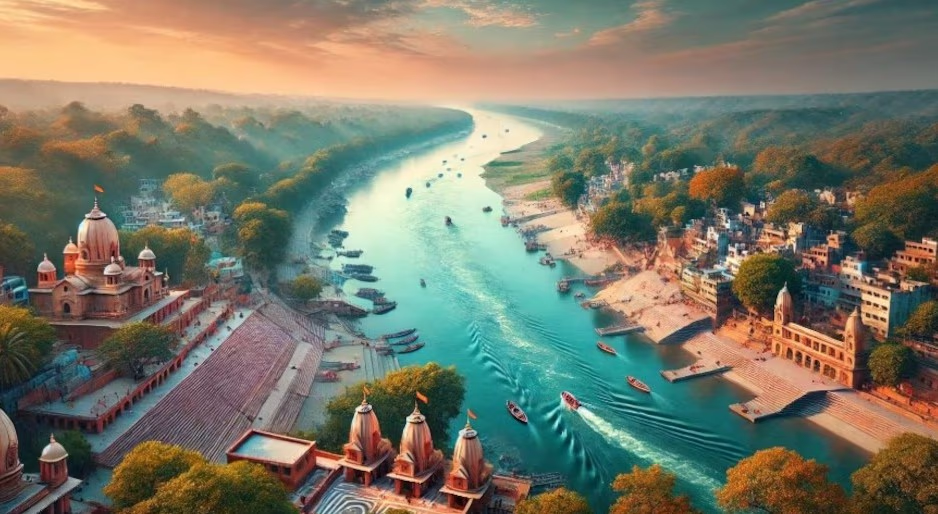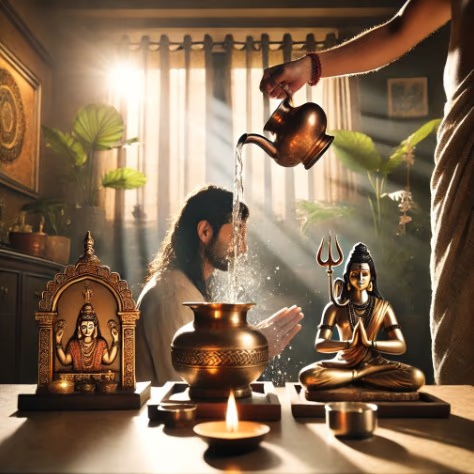In the world, India is unique in attributing divine significance to the five elements involved in creation. Here, the sky is known as Brahma, the Earth as Mother, and Agni is the deity of energy. Wind holds its divine status as Pavandev, while water is revered as Varunadev.
All rivers and water sources flowing in India are seen as forms of Varunadev. The rivers, nurturing the vast lands with their waters and quenching the thirst of every being, are venerated as Mother and Goddess. Among these, the Ganga holds the highest esteem. Revered as both a deity and a mother, Ganga is not just sacred due to her descent from heaven but also due to the blessings of sages and seers. It's believed that the boons granted to the Goddess also bless those who bathe in her waters.
The Many Names of the River Ganga in Local Faith
Emerging from the womb of the Himalayas, the Ganga nurtures the northern plains and unites with the Bay of Bengal. On this journey, she is called by various names in folk reverence, enhancing the purity of her waters. Bathing in the Ganga is vital to learn the virtues of simplicity and fluidity as water. Let go of all pride and emerge from the ghats a superior human being. These teachings of the Ganga are reflected in her many names. Myths and legends from scriptures to folklore speak of the grandeur of Ganga in numerous names.

Source: aajtak
Mythical Splendor of Ganga: Brahmkanya, Vishnupadi, Jatashankari
Emerging from Brahma's Kamandal, she is Brahmkanya; residing at Lord Vishnu's feet, she is Vishnupadi. As the daughter of the Himalayas, she is called Himsuta, and as a river in the realm of gods, she is Devanadi. Flowing through three worlds, she becomes Tripathaga, and when Lord Shiva grants shelter in his locks, she becomes Jatashankari. The magnificence of Ganga, worshiped by many names like Tribhuvan Tarini, Sursarita, Amisalila, and Punya, is sung in the scriptures.
Swami Akhandanand, president of Vishalakshi Shaktipeeth in Prayagraj, relates Ganga's majesty while referencing Baba Tulsi. He quotes from Ramcharitmanas:
"Blessed is the land where Surasari flows, Blessed are the women who follow chastity.."
This nation is blessed where the divine river Ganga flows and where women adhere to purity. Ganga is perceived as a living divine force, a nurturing mother, and a pillar of spiritual philanthropy. Bhagwati Ganga is recognized as Hariswaroopa, Haribhakt, and dear to Haribhakt.
In 'Shabd Kalpadrum', the etymology of 'Ganga' is explained as such:
‘She who takes, reaches, or reveals the sacred feet is Ganga’.
Ganga is supreme among rivers. Thus, in the Gita, Lord Krishna refers to himself as the Ganga -
‘Among streams, I am Ganga’ (Bhagavad Gita)
The Ganga's holiness is acknowledged even in the Rigveda –‘
This is my Ganga, Yamuna, Saraswati, Shutudri’. (Rigveda)
‘In the Satya Yuga, all pilgrimage sites hold sway, in Treta Yuga, Pushkar stands out, in Dvapara, Kurukshetra is significant, and in Kali Yuga, the sanctity of Ganga is paramount.’ (Brihannaradiya Purana)
The water of Brahma's Kamandalu, Vishnu’s foot nectar, and Shiva's locks consecrate Ganga as the holy river. Ganga embodies two principles: motion and word. Wherever these two divine elements reside eternally in a flow, that is Ganga.
Bringing Goddess Ganga to Earth
The descent of Ganga to Earth wasn't an ordinary occurrence; it was the result of the intense meditation of many esteemed figures over thousands of years. According to mythological texts, the 60,000 sons of King Sagara, turned to ash by sage Kapil's curse, necessitated Ganga's descent for their salvation and peace.
First, King Sagara himself meditated for this, followed by King Anshuman for 32,000 years, King Dilip for 30,000 years, and then King Bhagiratha for 1,000 years of severe penance, ultimately bringing Ganga to Earth. King Bhagiratha performed penance standing on his right toe to appease Lord Shankar, who then agreed to receive Ganga upon his head. In Valmiki's Ramayana, King Bhagirath is referred to as 'Narashreshta' or the best among men.

Source: aajtak
The Date of Ganga's Descent: Ganga Dussehra
The date of Ganga's descent to Earth is considered to be when the rays of the Sun tormented living beings. Known for its scorching rays, Jyestha month is familiar to all. During the bright fortnight of Jyestha, in the constellation of Hasta, falls the tenth day, recognized as the day of Ganga’s descent. Bathing, giving charity, and taking vows on this day eradicate ten forms of sins. Consequently, this sacred festival is renowned as Ganga Dussehra, the obliterator of tenfold sins.
As documented in the Brahma Purana –
In the bright half of Jyestha month, On the tenth day with Hasta constellation, Ten sins are erased, Thus known as Dussehr.
The ten sins are described as–First - Physical
1. Grabbing an un-gifted item.
2. Unlawful violence.
3. Bearing illicit relations.
Second - Verbal
4. Speaking harshly.
5. Uttering falsehoods.
6. Backbiting.
7. Meaningless chatter.
Third - Mental
8. Coveting others' wealth.
9. Evil thoughts against others.
10. Skeptical intellect.
How Goddess Ganga Purifies Ten Types of Sins
On the Ganga Dussehra festival with Hasta constellation in Jyestha, offering ten balls of jaggery and sattu along with the mantra ‘Om Namah Shivaya Narayanya Dasha Haraya Ganga Swaha,’ and giving ten fruits, flowers, food offerings, and incense in groups of ten, along with ten priests donating ten measures of sesame, absolves a person from ten birth's sins.
Sages say the one bathing in Ganga embodies three divine figures. As Vishnu when stepping into Ganga waters, Shiva by submerging the head, and as Brahma when returning with a Kamandalu filled with Ganga water.
Ganga is our country's emblem, our heritage, and cultural identity. Ganga Dussehra coinciding with Environment Day highlights India's ancient wisdom and environmental consciousness. We must embrace our culture with true understanding and in its authentic form.




